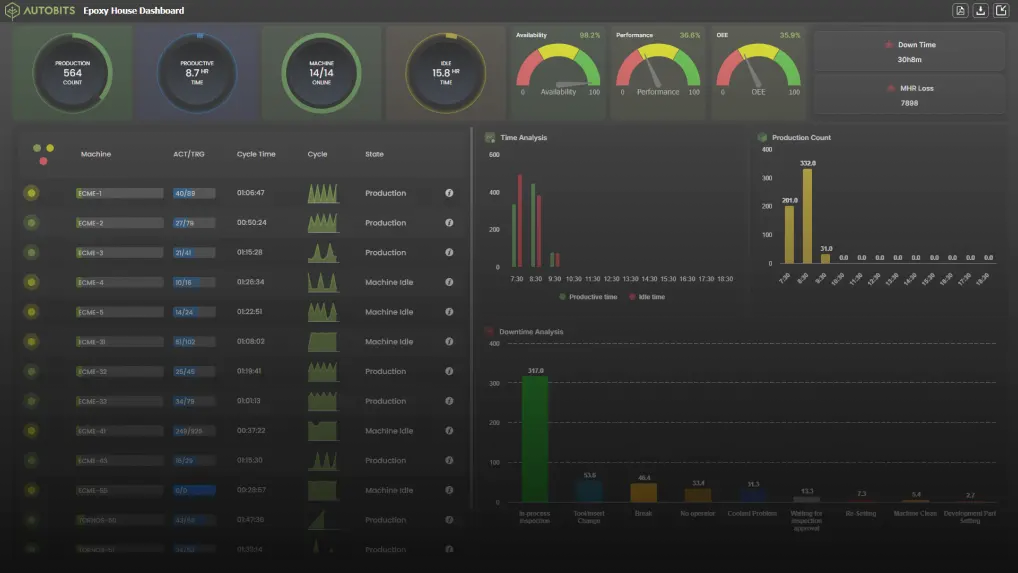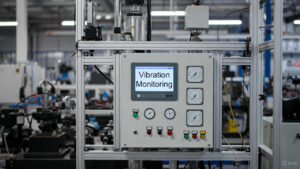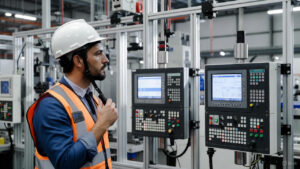In the era of digitalization, contemporary industries are unable to operate without a CNC machine monitoring system. CNC machines are automated machinery used for highly accurate machining tasks, including drilling, grinding, turning, and milling.
CNC machine monitoring system monitor Data on factors like machine utilization, spindle speed, tool changes, cutting forces, and production output. With the use of this data, producers can monitor machine performance, spot bottlenecks, enhance overall productivity, and optimize tooling and machining parameters.
Let’s explore how to implement the monitoring system and how it works on a CNC machine, as well as discuss the several advantages of monitoring systems in this post. And discuss how sensors, data acquisition hardware, and data analysis and visualization software are essential parts of a CNC machine monitoring system.
A CNC production monitoring system enables you to keep constant monitoring over your CNC manufacturing machines. Without an advanced factory floor solution, production visibility is confined to manual observation, making it hard to manage multi-stage manufacturing processes completely and achieve full transparency on your factory floor.
Our system incorporates all of the features listed below and more details, and its plug-and-play setup and cloud-based structure make it simple to use and install with no support needed.
Here’s a checklist of beneficial aspects of implementing the machine monitoring software and manufacturing data collection system:
The system for monitoring CNC machines gives you instant access to data about how well the machinery is performing. These systems assist in locating inefficiencies and bottlenecks in the manufacturing process by continuously monitoring variables including cycle times, spindle speeds, and tool usage.
Operators can optimize machine settings, quickly fix issues, and make necessary modifications to guarantee optimal production efficiency.
Overall productivity automatically increases with more efficiency and reduced downtime. CNC machine monitoring systems ensure the machinery is running as efficiently as possible. You can make more components faster without sacrificing quality by cutting down on idle time and optimizing machine utilization.
This approach can assist in streamlining workflow by offering real-time data acquisition that allows for better scheduling, leading to higher standards and more consistent production rates.
Managers may utilize previous data to identify trends and make well-informed strategic decisions, while operators can make quick adjustments to enhance equipment performance. The insights obtained from data monitoring can influence buying machinery, process enhancements, and maintenance schedules.
Industries can improve operational efficiency and foster long-term growth by making data-driven decisions with a clear grasp of machine performance and production indicators.
Once your requirements are well defined, you may start looking into several CNC machine monitoring systems. Ensure the system works with the CNC machines and other equipment you currently use. Look for features like real-time monitoring, data analysis tools, and integration possibilities that match your goals.
To ensure an effortless transfer of data between processes, compatibility also includes the capability to interface with an additional industrial system, such as an ERP or MES.
After selecting a monitoring system, the next step is to schedule its installation. Make a thorough implementation plan first, outlining every step required from installation to complete functioning. To monitor progress, create a timeline with distinct checkpoints.
Set up the required supplies for the implementation. This covers the expense of the monitoring system in addition to any necessary extra equipment, software, and instructions.
The CNC machine monitoring system installation process includes a few essential phases. Start by configuring your CNC machines’ required gear, such as sensors and data-collecting devices. To ensure correct data collection, install the device according to the manufacturer’s instructions.
Set up the system so that it can communicate with your current systems and equipment. This could entail setting the criteria for data collection, integrating the system with other machinery, and tailoring it to your particular requirements.
Once the system is deployed and configured, you can start collecting data. Configure data collection variables to collect the key performance indicators (KPIs) that are most important to your goals. Machine uptime, cycle times, and tool usage are all common KPIs. Monitor and analyze the acquired data regularly to discover trends and opportunities for improvement.
Implementing a CNC machine monitoring system is not a one-time operation. it requires ongoing optimization. Regularly evaluate system performance and make any necessary changes to increase accuracy and efficiency. This may require updating software, calibrating sensors, or adjusting data-collecting parameters.
Continuously optimize the system parameters for optimal outcomes. This iterative method will allow you to get the most out of your monitoring system.
In this post, we discuss that implementing a CNC machine monitoring system in your production entails several essential processes, including assessing your requirements, selecting the appropriate system, planning the deployment, and optimizing its performance. Following this advice will help you successfully establish a monitoring system that improves efficiency, decreases downtime, and increases productivity.
CNC machine monitoring provides enormous long-term benefits, making it an excellent investment for any modern organization. Take the initial step towards implementation now and optimize the potential of your CNC machines. Contact us for a demo!





